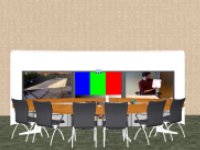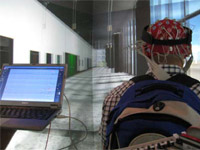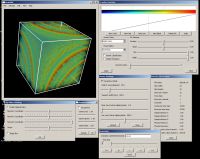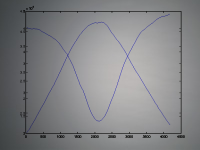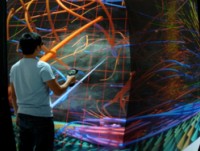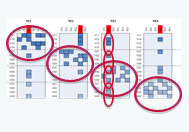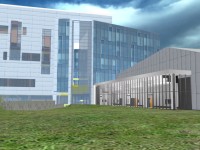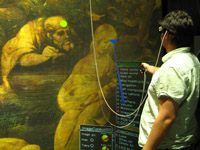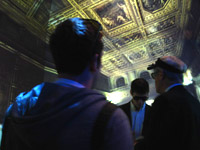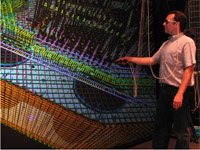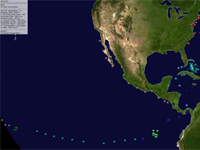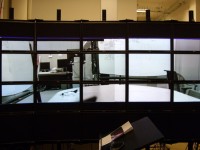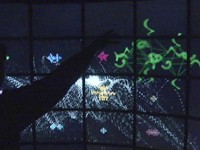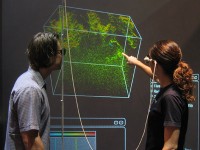Difference between revisions of "Projects"
From Immersive Visualization Lab Wiki
| Line 25: | Line 25: | ||
<td>[[Image:VelocityVectorField-small.png]]</td> | <td>[[Image:VelocityVectorField-small.png]]</td> | ||
<td>In this project, we are working on visualizing the blood flow in an artery, as simulated by Professor Bazilev at UCSD. Read the [[Blood Flow Manual]] for usage instructions.<br>Videos and pictures of the visualizations in 2D can be found [http://acsweb.ucsd.edu/~skoruga/bloodflow here], and the corresponding iPhone versions of the videos can be downloaded [[Media:iphone_videos.zip|here]].</td> | <td>In this project, we are working on visualizing the blood flow in an artery, as simulated by Professor Bazilev at UCSD. Read the [[Blood Flow Manual]] for usage instructions.<br>Videos and pictures of the visualizations in 2D can be found [http://acsweb.ucsd.edu/~skoruga/bloodflow here], and the corresponding iPhone versions of the videos can be downloaded [[Media:iphone_videos.zip|here]].</td> | ||
| − | |||
| − | |||
| − | |||
| − | |||
| − | |||
| − | |||
| − | |||
| − | |||
| − | |||
</tr> | </tr> | ||
</table> | </table> | ||
| Line 74: | Line 65: | ||
<hr> | <hr> | ||
| − | |||
| − | |||
| − | |||
| − | |||
| − | |||
| − | |||
| − | |||
| − | |||
| − | |||
| − | |||
| − | |||
| − | |||
| − | |||
| − | |||
| − | |||
| − | |||
| − | |||
===Neuroscience and Architecture (Daniel Rohrlick, Michael Bajorek, Mabel Zhang, 2007)=== | ===Neuroscience and Architecture (Daniel Rohrlick, Michael Bajorek, Mabel Zhang, 2007)=== | ||
| Line 145: | Line 119: | ||
<td>[[Image:sungod-small.png]]</td> | <td>[[Image:sungod-small.png]]</td> | ||
<td>UCSD Sasha Koruga has created a Photosynth-like system with which he can display a number of photographs in the StarCAVE. The images appear and disappear as the user moves around the photographed object. Read the [[PhotosynthVR Manual]] for usage instructions.</td> | <td>UCSD Sasha Koruga has created a Photosynth-like system with which he can display a number of photographs in the StarCAVE. The images appear and disappear as the user moves around the photographed object. Read the [[PhotosynthVR Manual]] for usage instructions.</td> | ||
| + | </tr> | ||
| + | </table> | ||
| + | <hr> | ||
| + | |||
| + | ===[[Mipmapped_Volume_Rendering|Multi-Volume Rendering]] (Han Kim, 2009)=== | ||
| + | <table> | ||
| + | <tr> | ||
| + | <td>[[Image:Volume_rendering.jpg]]</td> | ||
| + | <td>The goal of multi-volume rendering is to visualize multiple volume data sets. Each volume has three or more channels.</td> | ||
</tr> | </tr> | ||
</table> | </table> | ||
| Line 172: | Line 155: | ||
<td>[[Image:image-missing.jpg]]</td> | <td>[[Image:image-missing.jpg]]</td> | ||
<td>UCSD graduate Daniel Tenedorio is working on parallelizing the simulation algorithm of the Atlas in Silico art piece, supported by an NSF funded SGER grant. Daniel's goal is to be able to support the entire CAMERA data set, consisting of 17 million data points (open reading frames). Daniel is going to use the CUDA architecture of NVidia's graphics cards to achieve a considerable performance increase.</td> | <td>UCSD graduate Daniel Tenedorio is working on parallelizing the simulation algorithm of the Atlas in Silico art piece, supported by an NSF funded SGER grant. Daniel's goal is to be able to support the entire CAMERA data set, consisting of 17 million data points (open reading frames). Daniel is going to use the CUDA architecture of NVidia's graphics cards to achieve a considerable performance increase.</td> | ||
| + | </tr> | ||
| + | </table> | ||
| + | <hr> | ||
| + | |||
| + | ===Animated Point Clouds (Daniel Tenedorio, Rachel Chu, Sasha Koruga, 2008)=== | ||
| + | <table> | ||
| + | <tr> | ||
| + | <td>[[Image:rachel.jpg]]</td> | ||
| + | <td>UCSD students Daniel Tenedorio and Rachel Chu collaborated as PRIME students between NCHC in Taiwan and Osaka University. They worked on a 3D teleconferencing project, for which they used data from a 3D video scanner at Osaka University and streamed it across the network between NCHC and Osaka. Their VR application now runs in the StarCAVE at UCSD. Sasha Koruga has been continuing this project in the winter quarter 2009.</td> | ||
</tr> | </tr> | ||
</table> | </table> | ||
| Line 200: | Line 192: | ||
<td>[[Image:orion.jpg]]</td> | <td>[[Image:orion.jpg]]</td> | ||
<td>Under the direction of Matt Arrott, Philip created an interactive 3D exploration tool for simulated ocean currents in Monterey Bay. The software uses OssimPlanet to display terrain and bathymetry of the area to give context to streamlines and iso-surfaces of the vector field representing the ocean currents.</td> | <td>Under the direction of Matt Arrott, Philip created an interactive 3D exploration tool for simulated ocean currents in Monterey Bay. The software uses OssimPlanet to display terrain and bathymetry of the area to give context to streamlines and iso-surfaces of the vector field representing the ocean currents.</td> | ||
| + | </tr> | ||
| + | </table> | ||
| + | <hr> | ||
| + | |||
| + | ===[[CineGrid]] (Leo Liu, 2007)=== | ||
| + | <table> | ||
| + | <tr> | ||
| + | <td>[[Image:fountain-code.jpg]]</td> | ||
| + | <td>Computer science graduate student Leo Liu has been working on new algorithms for long distance 4k video streaming, as well as 4k movie data management. He has been working in close collaboration with the iRods group at the San Diego Supercomputer Center (SDSC) and has helped create iRods servers for CineGrid content in San Diego, Amsterdam, and Keio University in Japan.</td> | ||
</tr> | </tr> | ||
</table> | </table> | ||
Revision as of 14:30, 24 January 2011
Active Projects
TelePresence (Seth Rotkin, Mabel Zhang, 2010-)
CaveCAD (Lelin Zhang 2009)
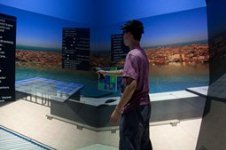 |
Calit2 researcher Lelin ZHANG provides architect designers with pure immersive 3D experience in virtual reality environment of StarCAVE. |
Blood Flow (Yuri Bazilevs, Jurgen Schulze, Alison Marsden, Ming-Chen Hsu, Kenneth Benner, Sasha Koruga; 2009-)
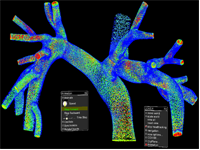 |
In this project, we are working on visualizing the blood flow in an artery, as simulated by Professor Bazilev at UCSD. Read the Blood Flow Manual for usage instructions. Videos and pictures of the visualizations in 2D can be found here, and the corresponding iPhone versions of the videos can be downloaded here. |
PanoView360 (Andrew Prudhomme, 2008-)
 |
In collaboration with Professor Dan Sandin from EVL, Andrew created a COVISE plugin to display photographer Richard Ainsworth's panoramic stereo images in the StarCAVE and the Varrier. |
SUN Blackbox (Mabel Zhang, Andrew Prudhomme, Seth Rotkin, Philip Weber, 2008-)
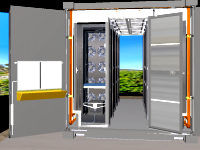 |
Mabel Zhang has been working on 3D modeling tasks at IVL. Her first task was to model the Calit2 building, which she completed as a Calit2 summer intern. We then hired her as a student worker to create a 3D model of the SUN Mobile Data Center which is a core component of the instrument procured by the GreenLight project. Andrew added an on-line connection to the Blackbox at UCSD to display the output of the power modules. Their project was demonstrated at the Supercomputing Conference 2008 in Austin, Texas. |
Khirbat en-Nahas (Kyle Knabb, Jurgen Schulze, 2008)
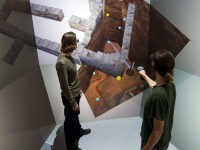 |
For the past ten years, a joint University of California, San Diego and Department of Antiquities of Jordan research team led by Professor Tom Levy and Dr. Mohammad Najjar has been investigating the role of mining and metallurgy on social evolution from the Neolithic period (ca. 7500 BC) to medieval Islamic times (ca. 12th century AD). Kyle Knabb has been working with the IVL as a master's student under Professor Thomas Levy from the archaeology department. He created a 3D visualization for the StarCAVE which displays several excavation sites in Jordan, along with artifacts found there, and radio carbon dating sites. In a related project we acquired stereo photography from the excavation site in Jordan. |
Spatialized Sound (Toshiro Yamada, Suketu Kamdar, 2008)
Neuroscience and Architecture (Daniel Rohrlick, Michael Bajorek, Mabel Zhang, 2007)
OssimPlanet (Philip Weber, Jurgen Schulze, 2007)
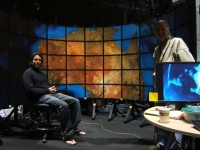 |
In this project we ported the open source OssimPlanet library to COVISE, so that it can run in our VR environments, including the Varrier tiled display wall and the StarCAVE. |
Protein Visualization (Philip Weber, Andrew Prudhomme, Krishna Subramanian, Sendhil Panchadsaram, 2005)
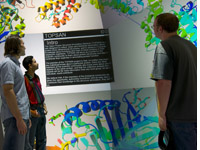 |
A VR application to view protein structures from UCSD Professor Philip Bourne's Protein Data Bank (PDB). The popular molecular biology toolkit PyMol is used to create the 3D models of the PDB files. Our application also supports protein alignment, an aminoacid sequence viewer, integration of TOPSAN annotations, as well as a variety of visualization modes. Among the users of this application are: UC Riverside (Peter Atkinson), UCSD Pharmacy (Zoran Radic), Scripps Research Institute (James Fee/Jon Huntoon). |
VOX and Virvo (Jurgen Schulze, 1999)
Documentation (Michael Robertson, 2011)
 |
The updating of the Wiki Projects Page. |
Inactive Projects
PhotosynthVR (Sasha Koruga, Haili Wang, Phi Nguyen, Velu Ganapathy; 2009-)
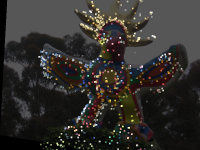 |
UCSD Sasha Koruga has created a Photosynth-like system with which he can display a number of photographs in the StarCAVE. The images appear and disappear as the user moves around the photographed object. Read the PhotosynthVR Manual for usage instructions. |
Multi-Volume Rendering (Han Kim, 2009)
 |
The goal of multi-volume rendering is to visualize multiple volume data sets. Each volume has three or more channels. |
How Much Information (Andrew Prudhomme, 2008-2009)
 |
In this project we visualize the data from various collaborating companies which provide us with data stored on harddisks or data transferred over networks. In the first stage, Andrew created an application which can display the directory structures of 70,000 harddisk drives of Microsoft employees, sampled over the course of five years. The visualization uses an interactive hyperbolic 3D graph to visualize the directory trees and to compare different users' trees, and it uses various novel data display methods like wheel graphs to display file sizes, etc. More information about this project can be found at [1]. |
Hotspot Mitigation (Jordan Rhee, 2008-2009)
ATLAS in Parallel (Ruth West, Daniel Tenedorio, Todd Margolis, 2008-2009)
Animated Point Clouds (Daniel Tenedorio, Rachel Chu, Sasha Koruga, 2008)
6DOF Tracking with Wii Remotes (Sage Browning, Philip Weber, 2008)
Video in Virtual Environments (Han Kim, 2008-)
LOOING/ORION (Philip Weber, 2007-2009)
CineGrid (Leo Liu, 2007)
Virtual Calit2 Building (Daniel Rohrlick, Mabel Zhang, 2006-2009)
Interaction with Multi-Spectral Images (Philip Weber, Praveen Subramani, Andrew Prudhomme, 2006-2009)
Finite Elements Simulation (Fabian Gerold, 2008-2009)
Palazzo Vecchio (Philip Weber, 2008)
Virtual Architectural Walkthroughs (Edward Kezeli, 2008)
NASA (Andrew Prudhomme, 2008)
Digital Lightbox (Philip Weber, 2007-2008)
Research Intelligence Portal (Alex Zavodny, Andrew Prudhomme, 2007-2008)
New San Francisco Bay Bridge (Andre Barbosa, 2007-2008)
Birch Aquarium (Daniel Rohrlick, 2007-2008)
CAMERA Meta-Data Visualization (Sara Richardson, Andrew Prudhomme, 2007-2008)
Depth of Field (Karen Lin, 2007)
HD Camera Array (Alex Zavodny, Andrew Prudhomme, 2007)
Atlas in Silico for Varrier (Ruth West, Iman Mostafavi, Todd Margolis, 2007)
Screen (Noah Wardrip-Fruin, 2007)
 |
Under the guidance of Noah Wardrip-Fruin and Jurgen Schulze, Ava Pierce, David Coughlan, Jeffrey Kuramoto, and Stephen Boyd are adapting the multimedia art installation Screen from the four-wall cave system at Brown University to the StarCAVE. This piece was displayed at SIGGRAPH 2007 and was the first virtual reality application to demoed in the StarCAVE. It was also displayed at the Beall Center at UC Irvine in the fall of 2007. For this purpose, it was ported to a single stereo wall display. |
Children's Hospital (Jurgen Schulze, 2007)
 |
From our collaboration with Dr. Peter Newton from San Diego's Children's Hospital we have a few computer tomography (CT) data sets of childerens' upper bodies, showing irregularities of their spines. |
Super Browser (Vinh Huynh, Andrew Prudhomme, 2006)
Cell Structures (Iman Mostafavi, 2006)
Terashake Volume Visualization (Jurgen Schulze, 2006)
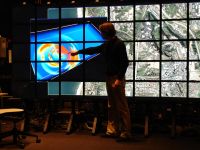 |
As part of the NSF funded Optiputer project, Jurgen visualized part of the 4.5 terabyte TeraShake earthquake data set on a the 100 megapixel LambdaVision display at Calit2. For this project, he integrated his volume visualization tool VOX into EVL's SAGE. |
Earthquake Visualization (Jurgen Schulze, 2005)
 |
Along with Debi Kilb from the Scripps Institution of Oceanography (SIO) we visualized 3D earthquake locations on a world-wide scale. |
